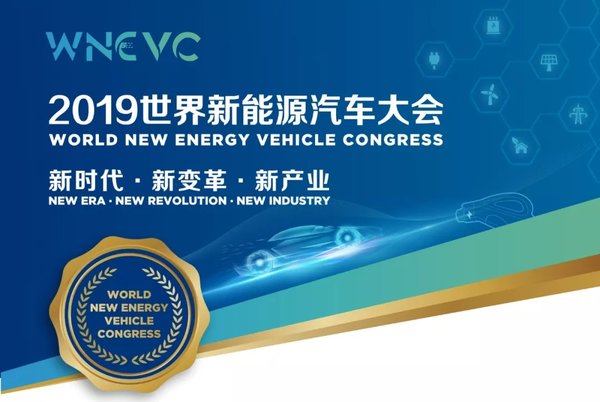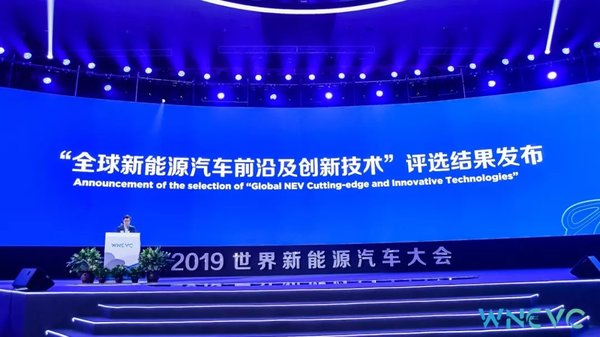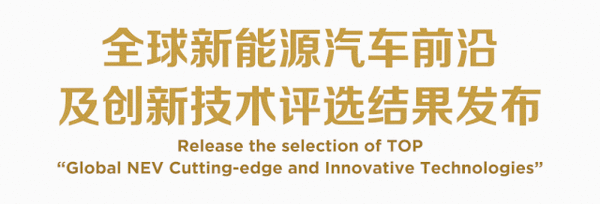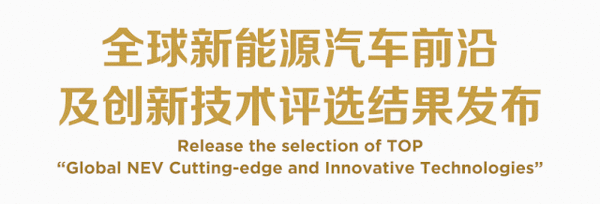

2019世界新能源汽车大会7月1-3日在海南博鳌举办,大会邀请来自全球新能源汽车主要技术领域的30余位知名专家学者,组成科技委员会,负责本次评选工作。本次评选确定了创新技术及前沿技术的评选标准,成果征集渠道包括企业自愿申报及科技委员会专家提名。

清华大学教授、中国科学院院士、世界新能源汽车大会科技委员会联合主席欧阳明高发布评选结果
创新技术
在新能源汽车领域中创造出的一种新技术,可解决新能源汽车关键核心领域技术难点、技术瓶颈的重要应用性技术。参评的创新技术需在产品上得到实际应用,产品形态为投放市场。
前沿技术
具有前瞻性、先导性和探索性的重大技术,可成为新能源汽车未来产品技术更新换代和推动产业发展的重要基础性技术。
评选工作于2019年3月份正式启动,共征集了百余项创新技术,50余项前沿技术。经过最后评审,有8项创新技术,8项前沿技术被评为2019年“全球新能源汽车前沿及创新技术“。

创新技术
华为5G+C-V2X车载通信技术
华为5G+C-V2X车载通讯技术助力5G时代智能网联汽车的发展。5G的高速率和低时延特性可支持智能汽车更快获取高精度地图等道路数据;C-V2X可支持车辆与道路基础设施、其他车辆、弱势交通参与者等进行直连通讯,该技术基于华为自主研发的5G车载通信模组MH5000和5G通信芯片Balong5000实现。Balong5000是世界上第一款支持C-V2X车联网技术的5G芯片。
丰田汽车高功率密度电堆设计技术
丰田汽车的MIRAI是世界上第一款量产级别的燃料电池汽车,汽车所使用的燃料电池电堆功率密度可以达到3.1kW/L,代表了国际顶尖水平。为了提高燃料电池输出功率,MIRAI采用铂钴合金,催化活性提高了80%。同时,通过先进的电堆结构和控制手段,降低了燃料电池单片的尺寸,使燃料电池变得小型化和轻量化;相比上一版本,MIRAI的电堆电流密度提高了1.4倍。
宁德时代高比能快充锂离子电池技术
该技术将石墨负极材料用于快充电池,运用孔道优化和“快离子环”技术,在石墨表面打造一圈高速通道,大大提高锂离子在石墨负极的嵌入速度,可实现10~12min充电80%SOC,结合正负极极片的晶体取向和容量过量系数等参数调配,配套机械件、热管理和快充BMS设计,使化学体系和电池设计参数达到最优匹配,在实现快充的同时保持高能量和长寿命等特点。
特斯拉基于SiC MOSFET的电机控制器
电机控制技术是打造高性能电机系统的关键。特斯拉开发并量产了基于SiC MOSFET的大功率电机控制器。基于SiC MOSFET的电机控制器开关频率高,耐热性能好且损耗低,并使得电机进一步小型化和轻量化。该技术可降低电动汽车工况循环电耗,增加车辆单次充电续驶里程。目前,该电控技术已大批量应用于Model 3纯电动车。
日产e-POWER技术:发动机发电专用、纯电机驱动
日产汽车的e-POWER技术利用纯电动汽车控制技术和零部件技术,将发动机调校成发电专用的规格和设置,通过优化电池的容量和功率以及发电的功率和时机,成功实现了低油耗节能减排效果。利用e-POWER驱动系统与发动机物理分离的技术,无需考虑工况,可以选择油耗最佳的发动机工作点,从而有效提高发动机热效率。
戈尔膨体聚四氟乙烯增强超薄质子交换膜技术
增强超薄质子交换膜是目前几乎所有量产燃料电池汽车必选的关键材料。戈尔公司的膨体聚四氟乙烯增强超薄质子交换膜具有独特的超薄膜结构增强设计,对导电树脂和添加剂的优选以及特殊生产工艺,实现了性能,耐久性和综合成本的平衡,为燃料电池汽车走向产业化提供了保障。
比亚迪汽车高效大功率轮边驱动系统关键技术
比亚迪汽车的高效大功率轮边驱动系统关键技术,包括电机与驱动桥轮边深度集成技术、电机铁芯直冷技术、分布式精准控制技术、IGBT复用融合技术等先进创新技术,解决了纯电动城市客车全通道低地板的技术难题。该技术属中国首创且已大批量应用在纯电动城市客车上。
宝马eDrive电力驱动技术
宝马eDrive电力驱动技术拥有超凡紧凑的设计。该技术将电机、传动系统、以及动力电子设备整合化一,可搭载在不同的车型结构中,包括插电式混合动力车型或者纯电动车型。基于模块化的动力单元设计,可以灵活组合不同尺寸,性能和结构形状的电机和动力电池。这一技术在车辆性能、续航里程、重量、空间和灵活性方面均带来显著优化。
前沿技术
智能驾驶汽车合成孔径雷达
合成孔径雷达属于一种高分辨率成像雷达,它的基础原理是雷达利用汽车平台的运动,将不同位置的回波进行合成处理,虚拟出很大的天线孔径,借此将方位向分辨率提升至毫米级。随着智能驾驶的兴起,该技术可以应用高精度地图定位以及代客泊车等汽车领域。
固态锂电池
固态锂电池具有高能量密度,高安全性和长循环寿命的突出优点。固态锂电池的固态电解质能与正极形成稳定的界面,同时能够阻挡锂枝晶的穿刺,使得运用高电压的正极材料和高能量密度的锂金属负极成为可能。在提高安全性的同时提升锂电池的能量密度,极大地提升了新能源汽车的经济性和环保性。
智能网联汽车基础数据云控平台
智能网联汽车基础数据云控平台采用边缘云、区域云、中心云三级技术架构。以大数据驱动的群体决策为基础,解决了单车智能在感知范围、协同控制方面的技术瓶颈,实现全要素网联化感知与人车路协同控制,全面提高交通安全性,优化交通通行效率,促进智能网联驾驶与智慧交通的深度融合。
高功率密度碳化硅车用电机驱动控制器技术
碳化硅器件具有高温、高效和高频特性,应用到电机控制器上可提高其功率密度和效率,同时降低成本。技术关键是解决高温SiC芯片载流子输运机理、SiC模块封装系统多应力耦合机制、电磁干扰产生与传播机理三大科学问题,此外需要突破SiC芯片电流输运增强、SiC平面型双面冷却封装、控制器集成方法等关键技术。
三维编织碳纤维复合材料汽车轻量化技术
三维编织CFRP零部件成型是一种可从纤维直接制造纤维预制件的编织方法。与传统二维编织布铺层形成层合纤维预制件的方法相比,三维编织技术减少了裁切、铺放、预成型等工序,大幅降低了工艺环节及相应的工艺成本。该技术应用将在汽车结构设计、车身部件加工和整车制造等方面产生重大影响。
燃料电池动力系统—高比功率的车用燃料电池电堆
燃料电池电堆是燃料电池系统的核心部件,其比功率决定了车载发动机的动力性能和成本。高比功率的燃料电池电堆能在有限空间内实现高功率装载,提升汽车动力性能;同时在同样功率输出情况下,可以降低材料等硬件使用量,使电堆成本得到下降,从而加速燃料电池车商业化时代的到来。
分布式电驱动系统技术
分布式电驱动系统通常采用多个轮毂/轮边驱动系统代替传统电动汽车的一个集中驱动系统,具有传动链短、动力传递高效、结构紧凑、底盘布置方便的优点,为车辆模块化、系列化开发和车内空间设计营造了极大的发展空间,通过力矩分配和复合制动等电控技术,可显著提高车辆主动安全性,改善汽车行驶性能和能源效率。
电动汽车无线充电技术
电动汽车无线充电技术是一种利用电磁感应原理,通过非接触的方式为电动汽车进行充电的技术。该项技术的应用通常是在地面端与车载端各安装两个耦合线圈,利用两线圈之间的磁场耦合实现能量从发射端到接收端的传输。电动汽车的无线充电避免了车载充电机与地面端电源的直接电气连接,具有易操作性、高安全性、强环境适应性的特点。

Innovative Technology
5G&C-V2X IoV Connectivity Technologyof Huawei Technology Co., Ltd.
5G+C-V2X IoV communication technology developedby Huawei enables the development of intelligent connected cars in the 5G era.The 5G high-throughput and low-latency features can support smart cars toobtain road data such as high-precision maps faster; C-V2X can support directcommunication between vehicles and infrastructure, other vehicles, weak trafficparticipants, etc. The technology is implemented on self-developed 5Gautomotive communication modules MH5000 and 5G chipset Balong5000. It is world’s first 5G chipset to support C-V2X IoV technology.
High power density stack designtechnology of Toyota Motor Corporation
The Toyota MIRAI is the world's firstmass-produced fuel cell vehicle, which uses a fuel cell power density of3.1kW/L., representing the highest level in the world. MIRAI uses PtCo alloyand the catalytic activity was increased by 80%. Reduces the size of the fuelcell stack and improves the size and weight of the fuel cell through advancedstack structure and control means. Compared to the previous version, the MIRAIstack current density is increased by 1.4 times.
High Energy Density and Fast Charging Technologyfor Lithium Ion Power Battery of Contemporary Amperex Technology Co., Limited
In this technology, graphite negativeelectrode material is used to produce fast charging batteries, which utilizeschannel optimization and “fast ion ring” technology, and creates a high-speed channel on the surface ofgraphite, thereby greatly increases the intercalation speed of lithium ions inthe graphite negative electrode. It can achieve 80% SOC in 10~12 minutes, Withmodulating the designing parameters such as capacity excess coefficient andcrystal orientation of the positive and negative electrode plates, and applyingthe mechanical design of battery unit, the battery management system and thethermal management system at the same time, it optimally matches the chemicalsystem and battery design parameters, and the system with graphite achievesfast charge while preserving properties such as high energy density and longlife.
E-Motor Controller based on SiC MOSFETof Tesla Inc.
Motor control technology is the key tohigh-performance drivetrain design. Tesla developed and produced a high-powermotor controller based on SiC MOSFET which has the characteristics of highswitching frequency, high thermal endurance and low losses. This technologymakes the motor more compact and lighter further, and thus reduces vehiclecycle energy consumption and increases the mileage of a single charge. It isalready used in mass production for Tesla Model 3 all-electric vehicles.
NISSAN e-POWER:100%Electric Generation by Engine,100% Electric Motor Drive
NISSAN e-POWER technology achieves a betterfuel economy by utilizing the BEV control tech. & parts tech., changing thespecifications & settings of E/G for power generation, and optimizing thebattery capacity & power as well as power generation control strategy.e-POWER employs a technology that the drive system is completely separated fromthe E/G. With no need to consider the running cycles, the best fuel economyoperating point of E/G can be selected.
Expanded Polytetrafluoroethylene (ePTFE)Reinforced Ultra-thin Proton Exchange Membrane of W.L. Gore & Associates.,Inc.
Currently reinforced ultra-thin protonexchange membranes have been adopted by all mass produced FCV models. ePTFEreinforced ultra-thin proton exchange membrane of W.L. Gore & Associates.,Inc., characterized by the unique membrane reinforcement, ionomer and additives’ selection and advanced manufacture technologies, has achieved thebest balance of performance, durability and total cost ownership. It is believed it will be a dominanttechnology utilized in the mass commercialization of FCVs.
Key Technology of High-Efficiency andHigh-Power Wheel Motor Drive System of BYD Auto Industry Company Limited
The key technology of high-efficiency and high-powerwheel motor drive system of BYD Auto, including the advanced and innovativetechnologies of highly integrating motor and driving axle, directly cooling themotor core, distributed precision control and multiplexing and fusion based onIGBT, contributes to solve the technological difficulty of achieving full sizelow floor on buses, which is firstly invented in China and has been widelyapplied on the 100% electric city buses.
eDrive Technology of BMW AG
Highly-integrated eDrive technology developedby BMW AG has an extremely compact design. Electric motor, transmission andpower electronics are highly integrated into a single housing. Thanks to themodular design system of electric powertrain components, which enable toproduce both electric motors and high-voltage batteries of various sizes,performances and structural shape. It could be equipped with different drivesystem variants, including plug-in hybrid drive system or battery-electricsolution. This fresh package of technology brings considerable advances interms of performance characteristics, operating range, weight, packaging spaceand flexibility.
Cutting-edge Technology
AutonomousVehicle Synthetic Aperture Radar
Synthetic Aperture Radar (SAR) is a kind ofhigh resolution imaging radar. Its basic principle is that radar uses themotion of vehicle platform to synthesize echoes from different locations, so asto create a large antenna aperture, thereby improving the azimuth resolution tomillimeter level. With the rise of autonomous driving, this technology can beapplied to high-resolution mapping and automatic parking assistant and otherautomotive fields.
Solid-state Lithium Battery
Solid-state lithium batteries achieve ahuge improvement in energy density, safety and cycle life. A stable interfaceis formed between cathode and solid electrolyte, which suppresses the growth oflithium dendrites. Based on the exploitation of strong solid electrolyte andinert interface, high-voltage cathode materials and lithium metal anode can beapplied in the solid-state batteries, the energy density of which can bepromoted while improving safety, and the economy and environmental performanceof new energy vehicles will be improved.
Fundamental Data Cloud Control Platformfor ICV
The Fundamental Data Cloud Control Platformfor ICV adopts three-layer technology architecture including edge cloud,regional cloud and central cloud. It solves the technical bottleneck in sensingrange and cooperative control and realizes full factors connected sensing andV2X cooperative control improving traffic safety, traffic efficiency based onbig data driving group decision, so that the ICV and ITS will fuse deeply.
High Power Density Silicon Carbide MotorControllers for Electric Vehicles
SiC has advantages of high temperature, lowconduction resistance and high frequency, which is applicated to achieve highpower density, high efficiency and low cost of inverter. To achieve SiC highdensity inverter, there are three main scientific issues, including carrier transportmechanism of high temperature SiC chip, multi-physical coupling mechanism ofSiC module packaging, and electromagnetic interference generation andpropagation mechanism of inverter. Furthermore, key technologies need brokenthrough, such as carrier transport enhancing technology of SiC device, SiCplanar double-sided cooled packaging technology and integration method of SiCmotor controller.
Lightweight Technology of 3D BraidingCFRP Composites for Automobiles
3D braiding technology can manufacture fiberpreformed components from fiber roving directly. Compared with traditional 2Dmethod, 3D braiding reduces the cutting, laying and preforming processes, forwhich manufacturing steps and the relevant manufacturing cost can be reducedsignificantly. The application of 3D weaving technology will have significantimpacts on automotive structural design, body parts processing and vehiclemanufacturing.
Hydrogen Fuel Cell Engine Technology—High Specific Power Stack for Fuel Cell Vehicle
Fuel cell stack is the core component ofthe fuel cell system, which decides the power performance and cost of theengine. A fuel cell stack with higher specific power will realize higherautomotive power. Furthermore, higher specific power will reduce the cost offuel cell stacks. These factors will accelerate the coming of commercializationera of the fuel cell vehicles.
Distributed Electric Drive SystemTechnology
Distributed electric drive systems usuallyadopt multiple in-wheel or wheel-hub motors instead of the centralized drivesystem of traditional electric vehicles. With advantages of short powertrain,high efficiency, compact structure, convenient chassis layout, distributedelectric drive systems create a great development space for vehicle modularizedand serial development and interior design, can significantly improve vehicleactive safety, driving performance and energy efficiency through electroniccontrol technologies, such as torque vectoring control, hybrid brake strategyand so on.
Wireless Charging Technology forElectric Vehicles
Wireless charging technology for electricvehicles can charge an electric vehicle in a non-contact manner based onelectromagnetic induction principle. The application of this technology isusually to install two coupling coils on the ground end and the vehicle end,and the transmission of energy from the transmitting end to the receiving endis realized by the magnetic field coupling between the two coils. The wirelesscharging of the electric vehicle avoids the direct electrical connectionbetween the vehicle charger and the ground terminal power source, and has thecharacteristics of easy operation, high safety and strong environmentaladaptability.